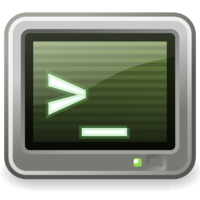MacOS terminal navigation
The filesystem on your computer is like a tree made up of folders (also called "directories") and files. The filesystem has a root directory called /, and everything on your computer lives in subdirectories of this root directory.
We often navigate the filesystem graphically by clicking on graphical folders. We can do the exact same navigation from the terminal.
There are three commands that we'll be using in the terminal to navigate the filesystem on your computer:
lspwdcd
ls lists the contents of a directory.
pwd gives the full directory path to your current directory.
cd moves you into a new directory (it stands for "change directory").
Let's practice using these commands.
Open a terminal
You can find the Terminal application through Spotlight, or navigate to Applications/Utilities/Terminal.
Practice using ls, pwd, and cd
(that's an l the letter, not the number 1)
Type each of these commands and hit enter:
ls
This lists all the files in your current directory.
pwd
This displays the full directory path to your current directory. (It's stands for "print working directory.")
cd /
This will change you into the / root directory.
ls
This lists the contents of the / root directory.
cd Users
This will change you into the Users subdirectory of the / root directory.
ls
You should see a list of all the files in /Users, including the directory for your username. The directory for your username (e.g. /Users/Jessica is often called your "home directory".
pwd
This displays the full directory path to your current directory, /Users.
cd ..
.. means "parent directory", so this command moved you up to the parent directory. You were in /Users, so now you are in /, the root directory.
ls
This lists the contents of the root directory, confirming where you are.
If you want to get back to your home directory, you can do:
cd Users
cd YOURNAME
where YOURNAME is the name of your User directory.
One helpful tip is that you can start typing a directory, then hit the TAB key and the terminal will autocomplete it.
Tips
- You can use Tab to auto-complete directory and file names. So from inside the root directory /, if you type
cd Usand hit Tab, the terminal will auto-complete the directory name, and you can then hit enter to change into the/Usersdirectory. - The terminal maintains a command history. You can use the up arrow to cycle through old commands.
Check your understanding
Answer these questions. Experiment at the terminal prompt if you need to! If you aren't sure about an answer, ask a helper.
- What directory are you in after starting a new terminal prompt?
- After starting a new terminal prompt, how would you get to the root directory?
- How do you check what files and directories are in your current working directory?
- If you are in directory /Users, and you want to get to /Users/jesstess/projects, how would you do that?
- What are 2 ways to avoid typing out a full navigation command? (hint: one requires that you've run the command before)
- What is the difference between a terminal prompt and a Python prompt?
Success!
You've practiced using ls, pwd, and cd to navigate your computer's filesystem from the terminal.



